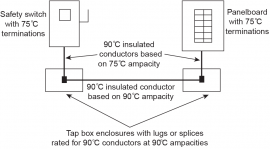Choice_Gorilla
Senior Member
- Location
- New England
- Occupation
- Journeyman Electrician
Maybe a stupid question but is there ever a situation where wire can be sized using the values in this column? I was always under the impression I could use it for derating purposes but when it came to actually sizing wire I was to use the 75 or 60 degree column. I’ve got an engineer telling me I can use the 90 degree column because I’m terminating directly to bus bar with 90 degree rated lugs or crimps. Never sized wire this way so it seems wrong. I’m not one to argue unless I can back it up with code references. If it matters, one side is a MCC and the other is a large motor. I can’t find anything on either that has a temperature rating.

